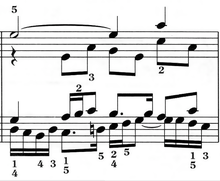
Back Kontrapunt AF Kontrapunkt ALS طباق (موسيقى) Arabic Contrapuntu AST Кантрапункт BE Кантрапункт BE-X-OLD Контрапункт Bulgarian Contrapunt Catalan کاونتەرپۆینت CKB Kontrapunkt Czech
In music theory, counterpoint is the relationship of two or more simultaneous musical lines (also called voices) that are harmonically interdependent yet independent in rhythm and melodic contour.[1] The term originates from the Latin punctus contra punctum meaning "point against point", i.e. "note against note". John Rahn describes counterpoint as follows:
It is hard to write a beautiful song. It is harder to write several individually beautiful songs that, when sung simultaneously, sound as a more beautiful polyphonic whole. The internal structures that create each of the voices separately must contribute to the emergent structure of the polyphony, which in turn must reinforce and comment on the structures of the individual voices. The way that is accomplished in detail is ... 'counterpoint'.[2]
Counterpoint has been most commonly identified in the European classical tradition, strongly developing during the Renaissance and in much of the common practice period, especially in the Baroque period. In Western pedagogy, counterpoint is taught through a system of species (see below).
There are several different forms of counterpoint, including imitative counterpoint and free counterpoint. Imitative counterpoint involves the repetition of a main melodic idea across different vocal parts, with or without variation. Compositions written in free counterpoint often incorporate non-traditional harmonies and chords, chromaticism and dissonance.
- ^ Laitz, Steven G. (2008). The Complete Musician (2 ed.). New York: Oxford University Press, Inc. p. 96. ISBN 978-0-19-530108-3.
- ^ Rahn, John (2000). Music Inside Out: Going Too Far in Musical Essays. intro. and comment. by Benjamin Boretz. Amsterdam: G+B Arts International. p. 177. ISBN 90-5701-332-0. OCLC 154331400.

